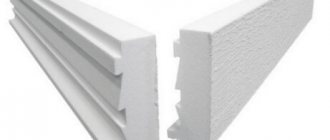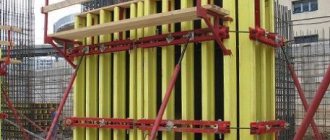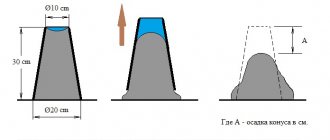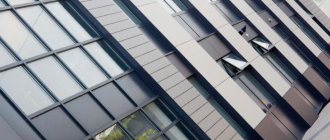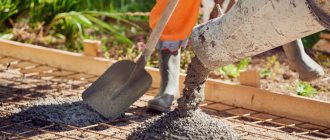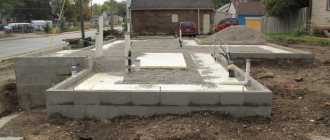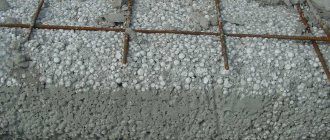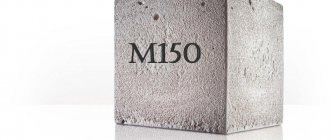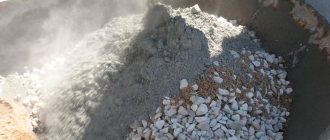Characteristics of fiber
Polypropylene fiber for screed is a complete replacement for metal reinforcement.
It has many advantages compared to metal fiber.
Comparative characteristics of fiber fiber and metal for reinforcement are given in the table:
| Bending tensile strength | General shrinkage (when completely dry) | |||||
| MPa | % | Mmm | % | |||
| F1 | 0,00 | 29,2 | 1,63 | 100 | 1,32 | 100 |
| F-2 | 0,95 | 26,0 | 2,27 | 139 | 0,93 | 70 |
| F-3 | 1,43 | 27,1 | 2,56 | 157 | 0,81 | 61 |
| F-4 | 1,90 | 28,7 | 2,80 | 172 | 0,54 | 41 |
| Fiber | |||
| Indicators | Polypropylene | Metal | Basalt |
| Destruction due to humidity, corrosion | Not affected | Susceptible | Not affected |
| Electrostatics | Not electrified | Electrified | Not electrified |
| Price | Average | Low | High |
| Strength | Sufficient (0.9-0.95 g/cu m), lower than metal | High | The integrity of the base will be maintained even with through cracking of the concrete solution |
| Use in rooms with high gravity loads, vibration and high traffic | Not recommended | Fits | Can be used in seismically active areas, in the north, and in rooms with high humidity |
The longer the fiber, the more loads the concrete will withstand
The fiber is produced in the form of crumbly material, its fiber length ranges from 6 to 20 cm. The length of the fibers affects the scope of application:
- for cladding and masonry, fibers 6 mm long are used;
- fiber for concrete screed and construction of monolithic objects should have a length of 12 mm;
- when constructing dams and other structures used in aggressive environments, you will need material 18 mm long.
When purchasing, you need to check whether the product has a certificate. If you buy low-quality material, it will not perform the required functions and may release harmful substances into the air.
Consumption of polypropylene fiber
Consumption rates for polypropylene fiber fiber
| Types of jobs | Fiber consumption per 1 m3 (kg) | Fiber Length(mm) | ||
| 18 | 12 | 6 | 3 | |
| Concrete floor slabs | 0,5-5 | + | + | |
| Marine defenses | 0,6-6 | + | + | |
| Shotcrete application of concrete | 0,3-3 | + | ||
| Warehouse sites | 0,3-2 | + | + | |
| Agricultural buildings | 0,3-2 | + | ||
| Precast concrete | 0,3-1 | + | ||
| Decorative printed concrete | 0,3-1 | + | + | |
| Pile production | 0,6-2 | + | + | |
| Hydraulic structures | 0,6-5 | + | + | |
| Stamped concrete | 0,3-1 | + | ||
| Bridges | 0,5-5 | + | ||
| Roads | 0,5-1,5 | + | + | |
| Blind area | 0,5-1 | + | + | |
| Screed, c. incl. warm floor | 0,5-1 | + | + | + |
| Plaster | 0,6-1 | + | + | + |
| Concrete repair materials | 0,5-1 | + | + | + |
| Foam concrete | 0,6-2 | + | + | |
| Products with metal fiber | 0,5-3 | + | + | |
| VibrocastingVibrocompression | 0,3-2 | + | + | |
| Polystyrene concrete | 0,5-10 | + | + | |
| Reinforced concrete | 2 | + | + | |
| Dry mixes | 0,6-1 | + | ||
| Cellular concrete | 0.1% by weight of foam concrete | + | + | |
| Non-reinforced concrete | 0,6-1 | + | + |
xn--64-nmce.xn--p1ai
Advantages of fiber fiber
The fibers are evenly distributed in the cement mortar by thoroughly mixing them and perform the function of reinforcement.
Fiber improves the quality of the mixture and accelerates hardening
Advantages of adding fibers to cement mortar:
- imparts strength and ductility;
- increases the service life of the base;
- frost resistance;
- does not burn, does not support combustion;
- protection against moisture penetration by reducing pores in concrete;
- shrinkage is eliminated;
- the concrete hardening time is reduced.
It is used to improve the properties of concrete mortar and prepare plaster compositions. It is used in the construction of structures in seismically active areas and areas exposed to aggressive environments.
Metal fiber Monopol FIBER Metal (packing: 25 kg)
Price per 1 kg: 60 rub.
Price for packaging 25 kg:
Brass-plated sections of low-carbon and high-carbon steel wire in accordance with GOST 3282, GOST 9389 or other TNLA with a temporary tensile strength from 900 to 3350 N/mm2.
FIELD OF APPLICATION Designed for strengthening cement mixtures and concrete in industrial floors and prefabricated structures.
Performs the function of concrete reinforcement. Increases the characteristics of concrete after it has gained strength, and also performs strength functions. Steel fiber, in the body of a concrete structure, is a randomly distributed reinforcement frame and significantly increases the bending and tensile strength of concrete slabs.
ADVANTAGES
- Tangible savings in time and labor (time and labor costs for laying and tying reinforcement are reduced).
- Noticeable cost savings due to the fact that the cost of fiber per 1 sq.m. structures are much cheaper than the consumption of steel reinforcement.
- Brass plating of the fiber makes it resistant to corrosion, both during storage and after laying in the concrete body. This property significantly extends the integrity of the reinforcement in concrete and increases the service life of the concrete structure.
- Compared to polypropylene microfiber, which can only be used in thin-layer screeds and to reduce surface cracking of a concrete floor, metal fiber can be used to reinforce a concrete floor.
APPLICATION The organization of work is carried out according to the technological map for laying the concrete floor. When a concrete mixer truck arrives with ready-mixed concrete, it is necessary to pour the fiber into the concrete mixer and mix thoroughly at high rotation speed for 1 minute per kg of poured fiber. When smoothing concrete, care must be taken to ensure that fibers do not protrude from the concrete. If you cannot smooth it with trowel discs and trowel blades, you need to remove it from the concrete. After finishing the concrete processing, it is necessary to conduct a visual assessment of the surface and if a separately protruding fiber is found, pull it out with pliers.
CONSUMPTION Consumption of MONOPOL FIBER Metal fiber is 30 kg per cubic meter of concrete. When producing ready-mixed concrete with steel fiber MONOPOL FIBER Metal, no adjustment of the granulometric composition of the mixture, cement and water content, or changes in the VCO are required.
STORAGE CONDITIONS AND SHELF LIFE Store in a dry place. Shelf life from date of manufacture: 3 years
PACKAGING Packing: 25 kg
PHYSICAL-CHEMICAL AND TECHNICAL CHARACTERISTICS
| Consumption per 1m3 of concrete, kg | 20-30 |
| Length, mm | 10-30 |
| Diameter (d), mm | 0,3+-10% |
| Coating | Brass |
| Type | Wave |
| Testing of fiber applications GOST 10180-2012 | Increase in tensile strength of concrete B22.5 (M300) up to 15% |
Fiber fiber screed installation technology
As with the installation of a conventional screed, you need to prepare the surface, mark the level of the subfloor, properly prepare the concrete solution and perform installation according to the described technology for performing the work.
Surface preparation
We remove the old floor covering, inspect the slab for defects and protruding reinforcement.
Nuances of screeds for heated floors
When pouring a heated floor, use the same proportions for preparing the mixture as for a regular screed
When installing heated floors, it is necessary to lay thermal and waterproofing material before pouring the concrete base to avoid heat loss.
Fiber for underfloor heating screed is used in the same proportions as for a conventional screed.
In addition to reinforcing additives, it is necessary to add plasticizers, which help to obtain an elastic screed that is resistant to high temperatures.
How to correctly calculate the consumption of metal fiber
On the RosFibra website, clients are offered a service such as a calculator for calculating the optimal amount of steel fiber for concrete solutions. The program is structured in such a way that each customer has the opportunity to independently determine the consumption of reinforcing fiber and order the required amount of steel fiber per 1 m3 of concrete mixtures.
It is important to remember that before ordering steel fiber, you need to decide for what purpose the concrete solution with steel fiber will be used. For example, we select the object “industrial premises” and be sure to indicate the area of pouring floor screeds made of steel fiber and concrete, fiber-reinforced concrete. Next, we decide on the thickness of the future floor. It should be noted that thanks to steel fiber in combination with concrete mortar, the builder has the opportunity to pour thinner industrial floor screeds while maintaining strength, reliability and resistance to abrasion and chemical influences. The consumption of steel fiber for concrete per m3 will depend on the expected height of the floors.
The next point is to choose the type of base. A new screed will require a slightly higher consumption of steel fiber and concrete mixture in order for the floors to become more durable. In the case of pouring onto the surface of an existing floor, the consumption of fiber per 1 m3 of screed is noticeably reduced. In any case, the use of steel fiber for the production of concrete mixtures can reduce construction costs and labor costs several times. Having specified all the parameters, the consumer will receive a result with the amount of steel fiber required for purchase per 1 m3 of concrete mixture.
Preparation of solution with fiber
- Preparing the base. The surface must not have defects or damage, and must also be primed and dried.
- The zero level is determined using a laser or water level and marked on the walls.
- Next, the beacon system is installed.
- Preparation of the solution. To better distribute the fiber in the mixture, first mix the dry ingredients and then add the required amount of water.
- Next, the prepared solution is placed on the surface and leveled according to the installed beacons using the rule. Next, after the floor has partially dried, it is necessary to remove the beacons and seal the resulting niches with mortar.
Then you need to wait time for the screed to fully mature, during this period to exclude the presence of drafts in the room.
Ready solution with additive
After reviewing this article, you learned the main advantages of using fiber for floor screeding. Based on the data obtained, draw a conclusion about the advisability of using this product in your case.
Application area
Recommended fiber size, mm
Fiber consumption
Industrial floors, cement concrete road surfaces
from 1 kg per 1 m 3 depending on the required strength characteristics
Screeds, heated floors
Calculation of fiber-reinforced concrete in construction
Fiber-reinforced concrete is a mixture obtained by combining building materials - steel fiber and concrete mortar. However, it is important to correctly calculate the ratio of these materials to obtain a high-quality mixture. We take into account the compatibility of steel fiber and concrete matrix; the fiber should be evenly distributed in the concrete solution; we correctly calculate the fiber consumption for concrete using the calculator on the RosFibra website.
Steel fiber is mixed in a concrete mixer along with the concrete mixture. Fiber is added in portions for uniform distribution. We calculate the amount of fiber per cube of concrete on a calculator and get an ideal solution of steel fiber and concrete - fiber-reinforced concrete. Fiber mixtures are used to fill industrial floor screeds with high strength and reliability. Floors of this type are not exposed to moisture, as well as various chemical materials. Steel fiber screed prevents the formation of cracks and tears during shrinkage, and is also resistant to mechanical damage.
